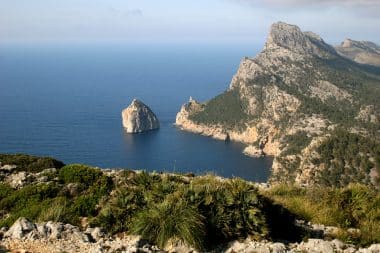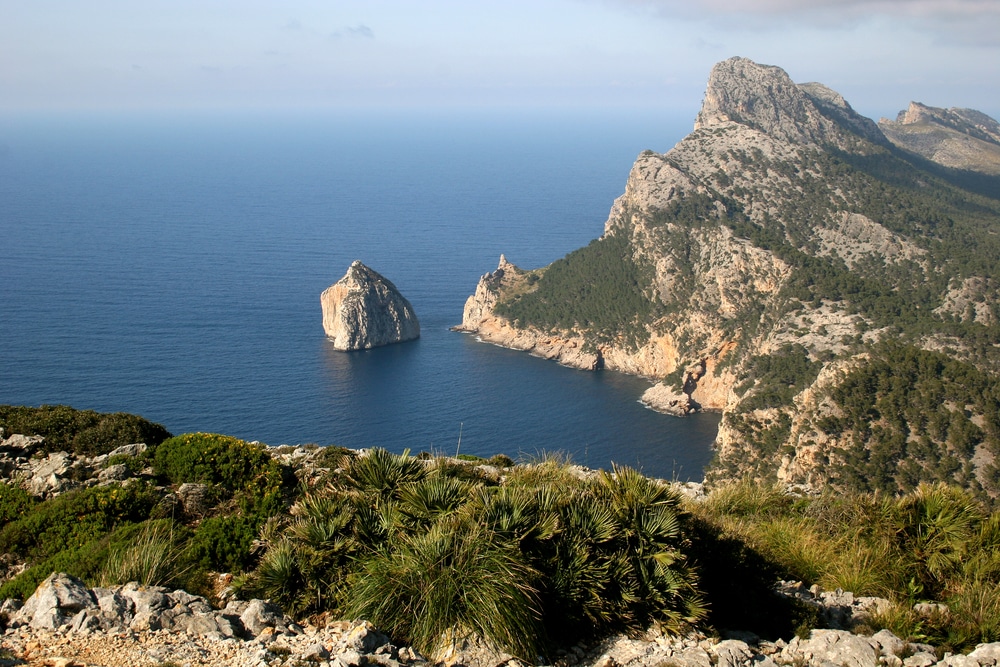A wild natural paradise between ancient cities and medieval castles
The third part of our Mallorca series takes us to the north of Mallorca today. At Cape de Formentor, the island shows its rough side. Anyone who reaches the northernmost tip of the cape holds their breath for a moment. The changing play of light and colours on the largely natural peninsula surprises even die-hard Mallorca connoisseurs.
No less astonishing is the landscape around the Lluc Monastery, which is hidden high in the Serra de Tramuntana. Almost behind every bend, a different view awaits the visitor. Idyllic finca oases, rugged rock faces, deep blue sea and impressive panoramas result in a picture-book landscape. An 18-kilometre-long dream road leads to one of Mallorca’s most striking landmarks. In the old town of Alcúdia and in the pretty artists’ town of Pollença, on the other hand, things are romantic.
From heavenly realms to picturesque old towns – wild and lovely at the same time
Three hundred and sixty-five steps to the sky, rural silence, mature old towns, architectural nightmares and extensive beaches – the north around Pollença and Alcúdia is a multifaceted area in terms of culture and landscape.
On the way to Cape Formentor

When the cliffs fall more than 200 meters deep into the turquoise blue sea, a road carved into the rock winds boldly from Port de Pollença to the lighthouse, and the Serra Tramuntana sinks into the sea, you can be sure that you have reached the “wild end” of Mallorca. The dramatic rocky landscape above turquoise blue bays shows its irrepressible side. From the lighthouse of Cape Formentor there is a fantastic view. In clear weather, you can even enjoy the view of the neighboring island of Menorca, 40 kilometers away.
Tip: Especially in the high season, the journey during the day is a nerve-wracking experience for car and motorcyclists. It is not uncommon for a large vehicle to suddenly appear behind the bend. Evasive maneuvers are rather difficult on the narrow track. Instead of crash barriers, only a small wall separates the car from the abyss. In the early morning hours or late afternoon, traffic is quieter. At this time, the lighting moods are also particularly impressive.
Just a few kilometres further south, the fine sandy and widely curved bays of Alcúdia and Pollença open up. If you like, you can take a break and linger in Cala Pi de la Posada. In the northeast of the island near Pollença, beach life beckons. The sand tickles under your feet, the pine trees smell in your nose and the sea is only a few steps away – Platja de Formentor is a wonderful place to indulge in the here and now.
In a beguiling setting, framed by a 300-metre-high rock face to the east, lies Cala de Sant Vincenç, just a few kilometres from Pollença.
Welcome to Pollença and the tranquil towns in the north of Mallorca
Anyone who has climbed the many steps to heaven, or more precisely: to the neo-Gothic chapel of the Calvary, can look forward to the countless earthly pleasures after his return
look forward. The café at the foot of the Stairway to Heaven spoils its guests with all kinds of delicacies.
The country town is an idiosyncratic place – a place for Mallorca connoisseurs, a place for lovers of beauty.
The staircase to the chapel and the narrow winding streets are unique on the island. Every Sunday, the most beautiful island markets take place in the small Plaça in front of the church and last but not least, Pollença is the city of artists. The mostly wealthy people of Pollençin cultivate traditional crafts, their own dialect and, above all, the arts. The town is home to a dozen art galleries. A slightly nostalgic touch is always present – Pollença stands out strongly from other provincial towns.
The popular tourist resorts of Alcúdia, Cala Sant Vicenç and Can Picafort
We leave the special town in a southerly direction and reach the wide curved bay with a golden sandy beach, the Bay of Alcúdia.
The town itself is the contrast to Pollença. The two parts of Alcúdia are like heaven and hell for some. Alcúdia is framed by its medieval city walls, nicely restored and photogenic. Port d’Alcúdia stretches from the harbour to Platja de Muro and then seamlessly merges into a hotel zone. Guests of all nations cavort here.
In summer, the bear rages, young people fill discos and pubs and countless people push their way through the streets. In contrast, the city centre seems almost dreamy. The car-free historic center is a well-preserved ensemble with buildings dating from the 13th to the 17th century. You can stroll wonderfully through the picturesque old town. On the Plaçeta de les Verdures rises the Casa Consistorial, with its magnificent clock tower. Flower-filled terraces and many restaurants invite you to linger. The pretty little shops make you want to browse.
The tranquil holiday resorts of Cala Sant Vicenç and Ca ́n Picafort are no less inspiring. Not far from the beautiful old town of Pollença, Cala Sant Vicenç is a secluded little settlement with beautiful scenery. A good choice for nature lovers.
Meanwhile, Can Picafort attracts with extensive, fine sandy beaches. Architecturally, the place is not a beauty, but German package holidaymakers in particular like to spend the most beautiful weeks of the year here. In any case, the town is completely geared towards tourists.
Mallorca, Part 1: Palma and the southwest coast
Mallorca, Part 2: In the northwest of Mallorca
Mallorca, Part 4: The Southeast of Mallorca
Mallorca, Part 5: The centre of Mallorca
Können wir Ihnen helfen?
Benötigen Sie Unterstützung bei Ihrer Reiseplanung oder weitergehende Informationen zu einzelnen Reisezielen? Wir freuen uns über Ihre Kontaktaufnahme.


